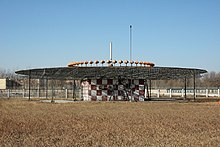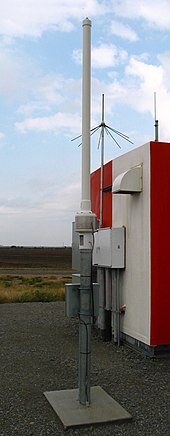338:
Low altitude transponders typically provide service to a minimum height of 18,000 feet (5,500 m) and range of 40 nautical miles (74 km); and High altitude transponders, which typically provide service to a minimum height of 45,000 feet (14,000 m) and range of 130 nautical miles (240 km). However, many have operational restrictions largely based on line-of-sight blockage, and actual performance may be different. The U.S. Aeronautical
Information Manual states, presumably referring to high altitude DME transponders: "reliable signals may be received at distances up to 199 nautical miles at line−of−sight altitude".
260:
174:
29:
37:
224:(1,852 m) to the target and back. The time difference between interrogation and reply minus the 50 microsecond ground transponder delay, and the pulse spacing of the reply pulses (12 microseconds in X mode and 30 microseconds in Y mode), is measured by the interrogator's timing circuitry and converted to a distance measurement (
271:). It's important to understand that DME provides the physical distance between the aircraft antenna and the DME transponder antenna. This distance is often referred to as 'slant range' and depends trigonometrically upon the aircraft altitude above the transponder as well as the ground distance between them.
379:
In 2020 one company presented its 'Fifth-Generation DME'. Although compatible with existing equipment, this iteration provides greater accuracy (down to 5 meters using DME/DME triangulation), with a further reduction to 3 meters using a further refinement. The 3-meter equipment is being considered as
199:
searches for reply pulse-pairs (X-mode = 12-microsecond spacing) with the correct interval and reply pattern to its original interrogation pattern. (Pulse-pairs that are not coincident with the individual aircraft's interrogation pattern e.g. not synchronous, are referred to as filler pulse-pairs, or
153:
In its first iteration, a DME-equipped airplane used the equipment to determine and display its distance from a land-based transponder by sending and receiving pulse pairs. The ground stations are typically collocated with VORs or VORTACs. A low-power DME can be collocated with an ILS or MLS where it
328:
three letter identity. If collocated with a VOR or ILS, it will have the same identity code as the parent facility. Additionally, the DME will identify itself between those of the parent facility. The DME identity is 1,350 Hz to differentiate itself from the 1,020 Hz tone of the VOR or the
304:
A typical DME ground-based transponder beacon has a limit of 2700 interrogations per second (pulse pairs per second – pps). Thus it can provide distance information for up to 100 aircraft at a time—95% of transmissions for aircraft in tracking mode (typically 25 pps) and 5% in search mode (typically
198:
150 interrogation pulse-pairs per second. The aircraft interrogates the ground transponder with a series of pulse-pairs (interrogations) and, after a precise time delay (typically 50 microseconds), the ground station replies with an identical sequence of pulse-pairs. The DME receiver in the aircraft
161:
A newer role for DMEs is DME/DME area navigation (RNAV). Owing to the generally superior accuracy of DME relative to VOR, navigation using two DMEs (using trilateration/distance) permits operations that navigating with VOR/DME (using azimuth/distance) does not. However, it requires that the aircraft
358:
are defined by the combination of their interrogation frequency, interrogation pulse spacing, reply frequency, and reply pulse spacing. These channels are labeled 1X, 1Y, 2X, 2Y, ... 126X, 126Y. X channels (which came first) have both interrogation and reply pulse pairs spaced by 12 microseconds. Y
313:
DME frequencies are paired to VOR frequencies and a DME interrogator is designed to automatically tune to the corresponding DME frequency when the associated VOR frequency is selected. An airplane's DME interrogator uses frequencies from 1025 to 1150 MHz. DME transponders transmit on a channel
337:
The U.S. FAA has installed three DME transponder types (not including those associated with a landing system): Terminal transponders (often installed at an airport) typically provide service to a minimum height above ground of 12,000 feet (3,700 m) and range of 25 nautical miles (46 km);
211:
Less than 30 interrogation Pulse-pairs per second, as the average number of pulses in SEARCH and TRACK is limited to max 30 pulse pairs per second. The aircraft interrogator locks on to the DME ground station once it recognizes a particular reply pulse sequence has the same spacing as the original
362:
A total of 252 frequencies are defined (but not all used) for DME interrogations and replies—specifically, 962, 963, ... 1213 megahertz. Interrogation frequencies are 1025, 1026, ... 1150 megahertz (126 total), and are the same for X and Y channels. For a given channel, the reply frequency is 63
274:
For example, an aircraft directly above the DME station at 6,076 ft (1 nmi) altitude would still show 1.0 nmi (1.9 km) on the DME readout. The aircraft is technically a mile away, just a mile straight up. Slant range error is most pronounced at high altitudes when close to the DME
68:
of radio signals in the frequency band between 960 and 1215 megahertz (MHz). Line-of-visibility between the aircraft and ground station is required. An interrogator (airborne) initiates an exchange by transmitting a pulse pair, on an assigned 'channel', to the transponder ground station. The
366:
Not all defined channels/frequencies are assigned. There are assignment 'holes' centered on 1030 and 1090 megahertz to provide protection for the secondary surveillance radar (SSR) system. In many countries, there is also an assignment 'hole' centered on 1176.45 megahertz to protect the GPS L5
69:
channel assignment specifies the carrier frequency and the spacing between the pulses. After a known delay, the transponder replies by transmitting a pulse pair on a frequency that is offset from the interrogation frequency by 63 MHz and having specified separation.
370:
Precision DME (DME/P), a component of the
Microwave Landing System, is assigned to Z channels, which have a third set of interrogation and reply pulse spacings. The Z channels are multiplexed with the Y channels and do not materially affect the channel plan.
72:
DME systems are used worldwide, using standards set by the
International Civil Aviation Organization (ICAO), RTCA, the European Union Aviation Safety Agency (EASA) and other bodies. Some countries require that aircraft operating under
401:
A feeling of sovereignty, or control over a state's own navigational means. "Some states want navigation over their territory to rely on means they control. And not every country has its constellation like the U.S.' GPS or Europe's
80:
While stand-alone DME transponders are permitted, DME transponders are usually paired with an azimuth guidance system to provide aircraft with a two-dimensional navigation capability. A common combination is a DME colocated with a
85:(VOR) transmitter in a single ground station. When this occurs, the frequencies of the VOR and DME equipment are paired. Such a configuration enables an aircraft to determine its azimuth angle and distance from the station. A
345:
or other instrument approach are intended for use during an approach to a particular runway, either one or both ends. They are not authorized for general navigation; neither a minimum range nor height is specified.
305:
150 pps). Above this limit the transponder avoids overload by limiting the sensitivity (gain) of the receiver. Replies to weaker (normally the more distant) interrogations are ignored to lower the transponder load.
235:, is used by the DME receiver to calculate its distance from the DME ground station. The rate in the calculation is the velocity of the radio pulse, which is the speed of light (roughly 300,000,000
571:
321:
Technical references to X and Y channels relate only to the spacing of the individual pulses in the DME pulse pair, 12 microsecond spacing for X channels and 30 microsecond spacing for Y channels.
318:
for interrogation and 126 channels for reply. The interrogation and reply frequencies always differ by 63 MHz. The spacing and bandwidth of each channel is 1 MHz and a bandwidth of 1MHz.
126:
band. This
Australian domestic version was referred to by the Federal Department of Civil Aviation as DME(D) (or DME Domestic), and the later international version adopted by
115:
387:
In the twenty-first century, aerial navigation has become increasingly reliant on satellite guidance. However, ground-based navigation will continue, for three reasons:
644:
363:
megahertz below or above the interrogation frequency. The reply frequency is different for X and Y channels, and different for channels numbered 1-63 and 64-126.
487:
Minimum
Operational Performance Standards for Airborne Distance Measuring Equipment (DME) Operating Within the Radio Frequency Range of 960-1215 Megahertz
709:
359:
channels (which were added to increase capacity) have interrogation pulse pairs spaced by 36 microseconds and reply pulse pairs spaced by 30 microseconds.
419:
137:
ranging function, except the roles of the equipment in the aircraft and on the ground are reversed. DME was a post-war development based on the
679:
165:
A typical DME ground transponder for en-route or terminal navigation will have a 1 kW peak pulse output on the assigned UHF channel.
104:(MLS) installations. In those situations, the DME transponder frequency/pulse spacing is also paired with the ILS, LOC or MLS frequency.
546:
314:
in the 962 to 1213 MHz range and receive on a corresponding channel between 1025 and 1150 MHz. The band is divided into 126
212:
interrogation sequence. Once the receiver is locked on, it has a narrower window in which to look for the echoes and can retain lock.
293:
283:
181:
The DME system comprises a UHF (L-band) transmitter/receiver (interrogator) in the aircraft and a UHF (L-band) receiver/transmitter (
93:) installation provides the same capabilities to civil aircraft but also provides 2-D navigation capabilities to military aircraft.
119:
530:
290:
organizations check periodically critical parameters with properly equipped aircraft to calibrate and certify DME precision.
77:(IFR) be equipped with a DME interrogator; in others, a DME interrogator is only required for conducting certain operations.
648:
381:
354:
DME frequency usage, channelization and pairing with other navaids (VOR, ILS, etc.) are defined by ICAO. 252 DME
279:
90:
704:
138:
134:
406:
One advantage of the fifth-generation equipment proposed in 2020 is its ability to be function-checked by
367:
frequency. These three 'holes' remove approximately 60 megahertz from the frequencies available for use.
145:. To maintain compatibility, DME is functionally identical to the distance measuring component of TACAN.
410:, which will significantly reduce the expense and delays of previous manned certification flight tests.
699:
628:
447:
714:
342:
278:
Radio-navigation aids must keep a certain degree of accuracy, given by international standards, FAA,
97:
82:
315:
101:
499:
Distance
Measuring Equipment (DME)Operating Within the Radio Frequency Range of 960-1215 Megahertz
107:
ICAO characterizes DME transmissions as ultra high frequency (UHF). The term L-band is also used.
430:
407:
74:
477:; International Civil Aviation Organization; International Standards and Recommended Practices.
436:
296:
recommends accuracy of less than the sum of 0.25 nmi plus 1.25% of the distance measured.
203:. Also, replies to other aircraft that are therefore non-synchronous also appear as squitter).
574:, Robert W. Lilley and Robert Erikson, Federal Aviation Administration, White Paper, undated
475:
Annex 10 to the
Convention on International Civil Aviation, Volume I – Radio Navigation Aids
583:
110:
Developed in
Australia, DME was invented by James "Gerry" Gerrand under the supervision of
20:
8:
585:
111:
425:
674:
154:
provides an accurate distance to touchdown, similar to that otherwise provided by ILS
526:
287:
162:
have RNAV capabilities, and some operations also require an inertial reference unit.
65:
391:
The satellite signal is extremely weak, can be spoofed, and is not always available;
664:
518:
236:
57:
684:
632:
517:(2nd ed.). National Academies of Sciences, Engineering, and Medicine. 2015.
259:
395:
562:; Federal Aviation Administration; Advisory Circular AC 90-100A; 1 March 2007.
398:
rule requires member states to keep and maintain ground-based navigation aids;
693:
584:
U.S. Department of
Defense and Department of Transportation (December 2001).
514:
Handbook of
Frequency Allocations and Spectrum Protection for Scientific Uses
268:
221:
155:
512:
142:
670:
UK Navaids Gallery with detailed Technical Descriptions of their operation
19:
This article is about the aviation equipment. For more general usage, see
225:
182:
61:
325:
501:; European Union Aviation Safety Agency; ETSO-2C66b; 24 October 2003.
608:
522:
442:
200:
173:
45:
669:
220:
A radio signal takes approximately 12.36 microseconds to travel 1
118:(CSIRO). Another engineered version of the system was deployed by
64:(distance) between an aircraft and a ground station by timing the
511:"Appendix B: IEEE Standard Letter Designations for Radar Bands".
228:), in nautical miles, then displayed on the cockpit DME display.
611:"U.S. National Aviation Standard for the VOR/DME/TACAN Systems"
572:"DME/DME for Alternate Position, Navigation, and Timing (APNT)"
114:
while employed as Chief of the Division of Radiophysics of the
86:
680:
U.S. National Aviation Handbook for the VOR/DME/TACAN Systems
623:
560:
U.S. Terminal and En Route Area Navigation (RNAV) Operations
158:(and, in many instances, permitting removal of the latter).
116:
Commonwealth Scientific and Industrial Research Organisation
28:
240:
127:
36:
609:
U.S. Federal Aviation Administration (2 September 1982).
123:
96:
Low-power DME transponders are also associated with some
324:
DME facilities identify themselves with a 1,350 Hz
549:. 9 January 2013 – via The Sydney Morning Herald.
308:
610:
177:
DME distance and VOR/ADF cockpit display instruments
635:; Federal Aviation Administration; 12 October 2017.
267:The accuracy of DME ground stations is 185 m (±0.1
349:
122:in the early 1950s operating in the 200 MHz
691:
263:Accuracy of various aviation navigation systems
40:DME antenna beside the DME transponder shelter
710:Length, distance, or range measuring devices
685:A free online VOR and ADF simulator with DME
420:Automatic dependent surveillance – broadcast
16:Radio navigation technology used in aviation
675:Flash based instrument simulator with DME
547:"Engineer exploded myths in many fields"
332:
258:
172:
120:Amalgamated Wireless Australasia Limited
35:
27:
243:). The time in the calculation is C. ½(
215:
692:
645:Thales Introduces Fifth-Generation DME
586:"2001 Federal Radionavigation Systems"
470:
468:
466:
464:
384:, with possible deployment by 2023.
341:DME transponders associated with an
461:
309:Radio frequency and modulation data
286:, etc. To assure this is the case,
13:
489:; RTCA; DO-189; 20 September 1985.
251:), where C is the speed of light.
14:
726:
658:
299:
638:
625:Aeronautical Information Manual
617:
133:DME is similar in principle to
602:
577:
565:
553:
539:
504:
492:
480:
350:Frequency usage/channelization
193:
1:
454:
206:
60:technology that measures the
148:
139:identification friend or foe
50:distance measuring equipment
7:
413:
254:
168:
112:Edward George "Taffy" Bowen
10:
731:
448:Transponder landing system
18:
374:
188:
100:(ILS), ILS localizer and
98:instrument landing system
89:(a VOR co-located with a
83:VHF omnidirectional range
631:5 September 2008 at the
102:microwave landing system
32:D-VOR/DME ground station
431:Instrument flight rules
75:instrument flight rules
437:Non-directional beacon
264:
233:distance = rate * time
231:The distance formula,
178:
41:
33:
333:DME transponder types
262:
176:
39:
31:
705:Aircraft instruments
216:Distance calculation
21:Distance measurement
426:Gee-H (navigation)
265:
179:
42:
34:
700:Navigational aids
532:978-0-309-37659-4
380:part of Europe's
288:flight inspection
185:) on the ground.
141:(IFF) systems of
66:propagation delay
722:
715:Radio navigation
652:
651:, 11 March 2020)
642:
636:
621:
615:
614:
606:
600:
599:
597:
595:
590:
581:
575:
569:
563:
557:
551:
550:
543:
537:
536:
508:
502:
496:
490:
484:
478:
472:
239:or 186,000
58:radio navigation
730:
729:
725:
724:
723:
721:
720:
719:
690:
689:
661:
656:
655:
643:
639:
633:Wayback Machine
622:
618:
607:
603:
593:
591:
588:
582:
578:
570:
566:
558:
554:
545:
544:
540:
533:
510:
509:
505:
497:
493:
485:
481:
473:
462:
457:
416:
377:
352:
335:
329:ILS localizer.
311:
302:
257:
218:
209:
196:
191:
171:
151:
135:secondary radar
24:
17:
12:
11:
5:
728:
718:
717:
712:
707:
702:
688:
687:
682:
677:
672:
667:
660:
659:External links
657:
654:
653:
637:
616:
601:
576:
564:
552:
538:
531:
523:10.17226/21774
503:
491:
479:
459:
458:
456:
453:
452:
451:
445:
440:
434:
428:
423:
415:
412:
404:
403:
399:
396:European Union
392:
376:
373:
351:
348:
334:
331:
310:
307:
301:
298:
256:
253:
217:
214:
208:
205:
195:
192:
190:
187:
170:
167:
156:marker beacons
150:
147:
15:
9:
6:
4:
3:
2:
727:
716:
713:
711:
708:
706:
703:
701:
698:
697:
695:
686:
683:
681:
678:
676:
673:
671:
668:
666:
663:
662:
650:
646:
641:
634:
630:
627:
626:
620:
612:
605:
587:
580:
573:
568:
561:
556:
548:
542:
534:
528:
524:
520:
516:
515:
507:
500:
495:
488:
483:
476:
471:
469:
467:
465:
460:
449:
446:
444:
441:
438:
435:
432:
429:
427:
424:
421:
418:
417:
411:
409:
408:drone flights
400:
397:
393:
390:
389:
388:
385:
383:
382:SESAR project
372:
368:
364:
360:
357:
347:
344:
339:
330:
327:
322:
319:
317:
306:
300:Specification
297:
295:
291:
289:
285:
281:
276:
272:
270:
261:
252:
250:
246:
242:
238:
234:
229:
227:
223:
222:nautical mile
213:
204:
202:
186:
184:
175:
166:
163:
159:
157:
146:
144:
140:
136:
131:
129:
125:
121:
117:
113:
108:
105:
103:
99:
94:
92:
88:
84:
78:
76:
70:
67:
63:
59:
55:
51:
47:
38:
30:
26:
22:
640:
624:
619:
604:
592:. Retrieved
579:
567:
559:
555:
541:
513:
506:
498:
494:
486:
482:
474:
405:
386:
378:
369:
365:
361:
355:
353:
340:
336:
323:
320:
312:
303:
292:
277:
273:
266:
248:
244:
232:
230:
219:
210:
197:
180:
164:
160:
152:
143:World War II
132:
109:
106:
95:
79:
71:
53:
49:
43:
25:
249:reply delay
226:slant range
194:Search mode
183:transponder
130:as DME(I).
62:slant range
694:Categories
665:DME Basics
455:References
326:Morse code
245:total time
207:Track mode
649:AW&ST
402:Galileo."
275:station.
149:Operation
629:Archived
443:Squitter
414:See also
356:channels
316:channels
255:Accuracy
201:squitter
169:Hardware
46:aviation
422:(ADS-B)
56:) is a
594:5 July
529:
375:Future
189:Timing
87:VORTAC
589:(PDF)
450:(TLS)
439:(NDB)
433:(IFR)
91:TACAN
596:2011
527:ISBN
294:ICAO
284:ICAO
280:EASA
241:mi/s
128:ICAO
519:doi
343:ILS
269:nmi
237:m/s
124:VHF
54:DME
44:In
696::
525:.
463:^
394:A
282:,
247:−
48:,
647:(
613:.
598:.
535:.
521::
52:(
23:.
Text is available under the Creative Commons Attribution-ShareAlike License. Additional terms may apply.



